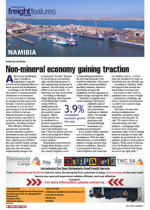As Namibia’s logistics sector forges ahead, Manica is positioning itself as a key player in the bulk cargo space at the Port of Walvis Bay. According to Patrick Kohlstädt, operations director at Manica, the company has invested heavily in infrastructureand operations to support its growing footprint in this specialised segment.“We are setting ourselves up as a bulk operator, particularly focused on commodities like fertiliser, sulphur, minerals and general project cargo,” said Kohlstädt. “Our investments include new facilities inside and outside the port – around 11 000 square metres within the port, and a six-hectare site just outside, previously used as a container depot. We are now exiting the container market to concentrate fully on bulk and project cargo.”Manica’s facilities are tailored for efficient cargo handling, with a particular focus on bulk-to-bulk and bulk-to-bag solutions. “We’ve invested in three bulk-to-one-tonne bagging machines quayside, which allow us to move product directly from ship to bag,” he explained. “It’s fast, efficient and avoids costly vessel delays – demurrage can reach up to thousands of dollars a day. Our goal is to get vessels turned around as quickly as possible, saving our clients time and money.”The company also offers a hybrid model to improve cost-efficiency further. “In some cases, we discharge directly into bulk trucks and move product to our warehouse for bagging at a later stage. This gives us f lexibility and helps manage costs,” said Kohlstädt.Fertiliser and sulphur, in particular, have seen rapid growth in Walvis Bay, with volumes more than doubling over the past 18 months, especially into Zambia and Zimbabwe. “It’s all about timing,” he said. “Fertiliser has to get into the ground at the right time of year to support growing agriculture sectors across the region. Congestion at traditional ports is driving more traffic our way, and the transport efficiencies through Walvis Bay are starting to make real economic sense.”He added that on the back of the growing oil and gas, renewable energy and burgeoning mining sectors, project cargo volumes were on the rise. “The corridor-destined cargo coming through Walvis Bay is increasing and we’re also seeing more project cargo entering Namibia. There are hydrogen projects in the pipeline and we’re already seeing prototypes being built and commissioned. Wind turbines are also being transported through Lüderitz, so there’s quite a bit happening in the renewable energy space.”According to Kohlstädt, Namibia is finally reaping the benefits of years of work. “This has been coming for years,” he said. “We’ve been marketing these corridors and the port for the past 20 years and it’s about time that we’re seeing the results.” The growing volume of cargo, which other ports struggle to accommodate, is proving advantageous for Walvis Bay. “The safety and reliability of our corridor play a big role, especially given the challenges faced by other ports. Cargo must still f low, and we are ready for it.”Kohlstädt added that it was not just local stakeholders who were benefiting, but international players as well. “We’re seeing major international companies taking notice of what’s happening here. They’re seeing the possibilities and the potential for growth in the region.”He said the company was actively engaged in the growing oil and gas sector, working with several customers currently running exploration campaigns in the Orange Basin. LV

